Gaps and leftovers: the anarchitecture of Gordon Matta-Clark
Lecture with Magnolia Costa
Service
Date: Monday, 6/13
Time: 7pm
Location: online via Zoom
Free tickets at alespacodearte.com
More information [email protected]
At this meeting, art critic Magnólia Costa talks about the positioning of artists in the face of transformations in the urban scene, involving issues such as gentrification and occupation of public areas. The discussion takes place around Gordon Matta-Clark’s interventions in New York in the 1970s. Matta-Clark challenged the modernist legacy by developing a pioneering work anchored in the concept of anarchitecture.
Magnólia Costa, PhD in Philosophy from USP, essayist, translator, art critic, curator and professor of art history. She taught at MAM São Paulo between 2001 and 2021, where she headed the Research and Publications Sector and served as head of Institutional Relations. She is the author of Nicolas Poussin: Idea of the landscape (Edusp, 2020) and founder of the distance learning platform that bears her name, active since 2019 and certified with the USP DNA seal of innovation. She regularly publishes articles on philosophy and art criticism on the blog Arte com Mag.
With 25 years of experience in teaching, Magnólia Costa has formed a wide repertoire of themes. In addition to European art, she teaches criticism of Brazilian art, culture and art, covering a historical arc that goes from the 15th century to the present day. Among her current research, stand out relational art, the action of museums in the geopolitical context, the relationship between art and nature, art produced by women and their presence in artistic institutions.
Magnólia Costa introduces criticism into the field of art history, that is, it analyzes the work of art in the light of philosophical concepts and the sociocultural context in which it was produced. Her classes open up a deeper field of reflection, where the approach to the artistic object favors the formation of synapses and, therefore, a new understanding of history.
